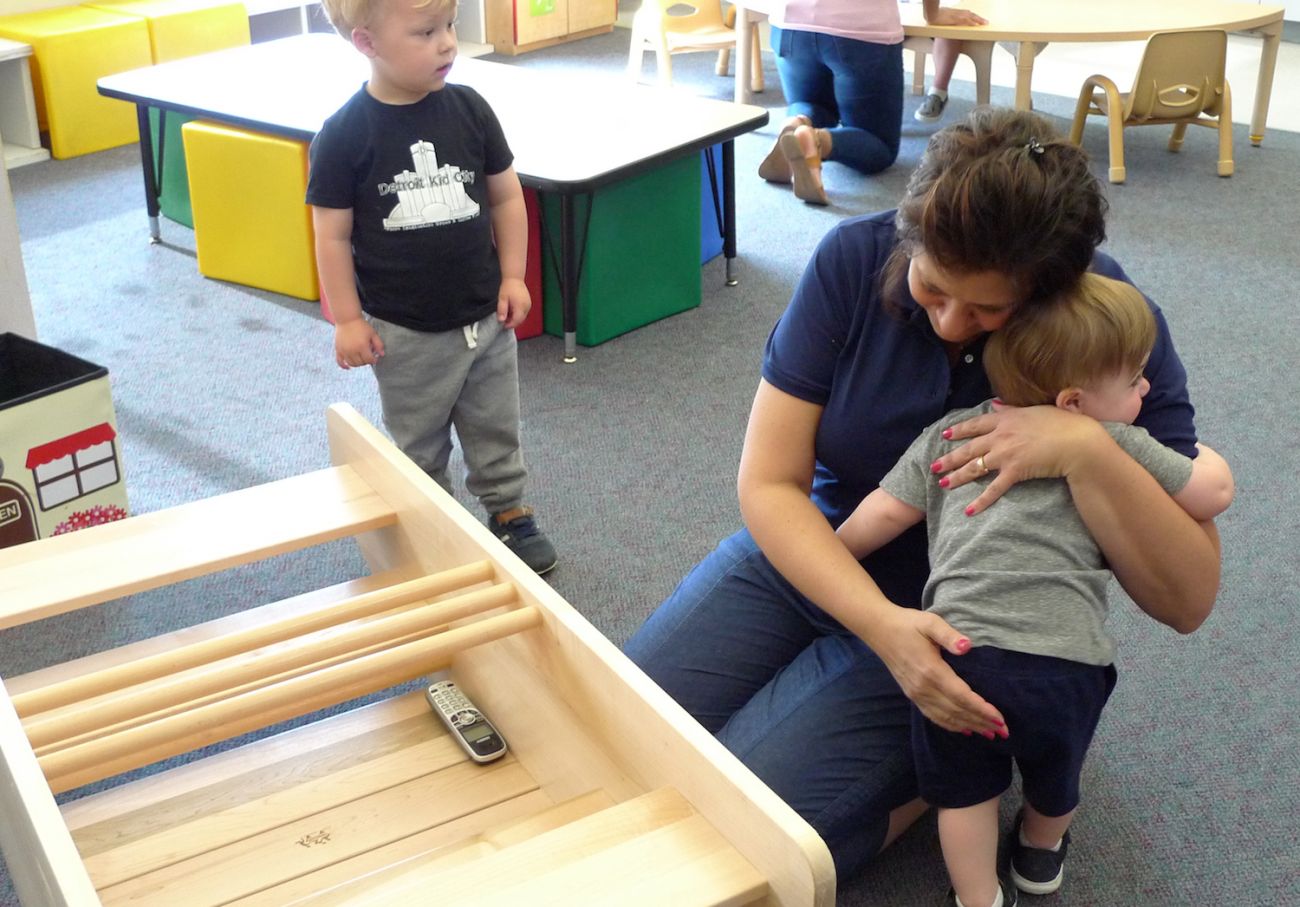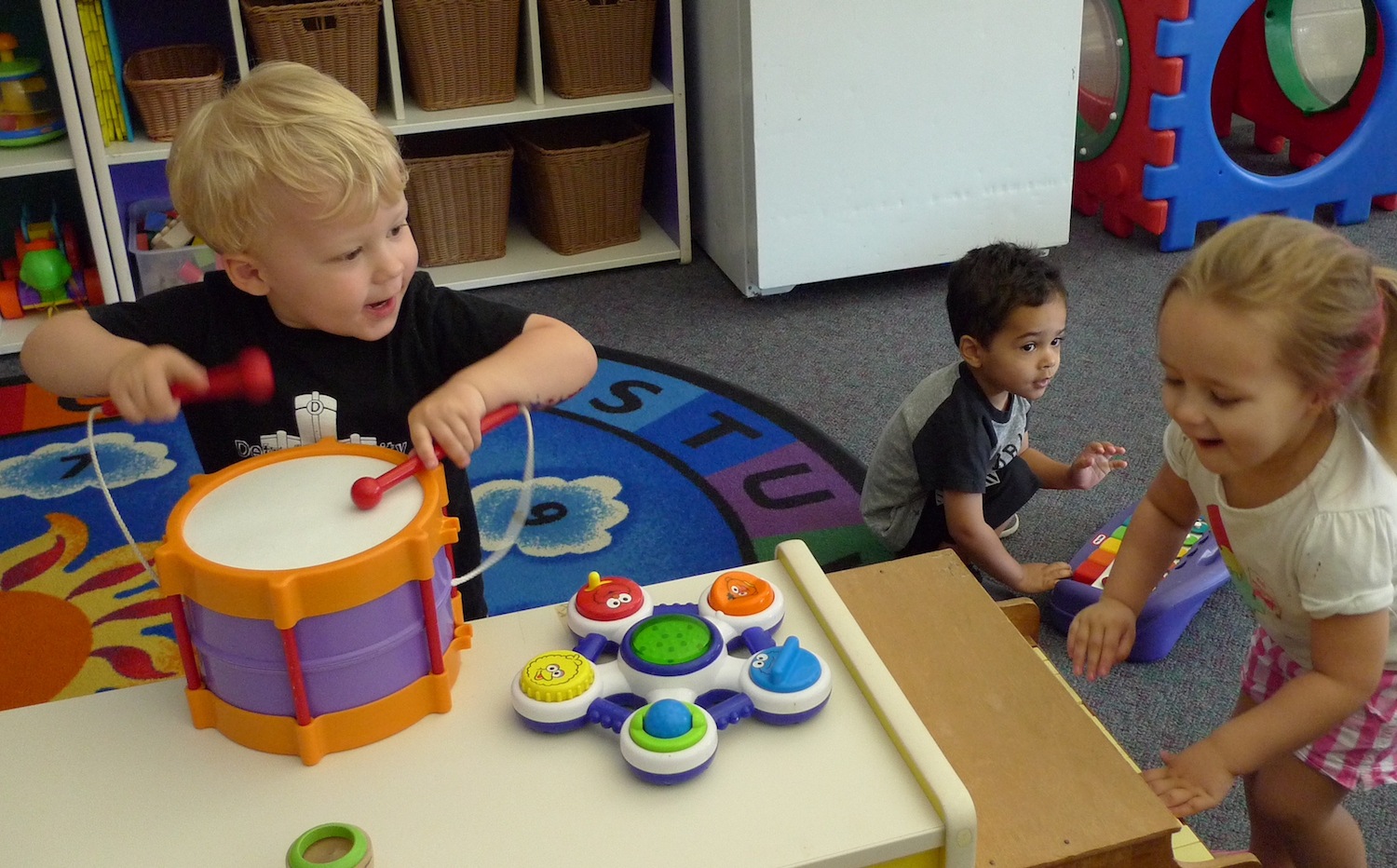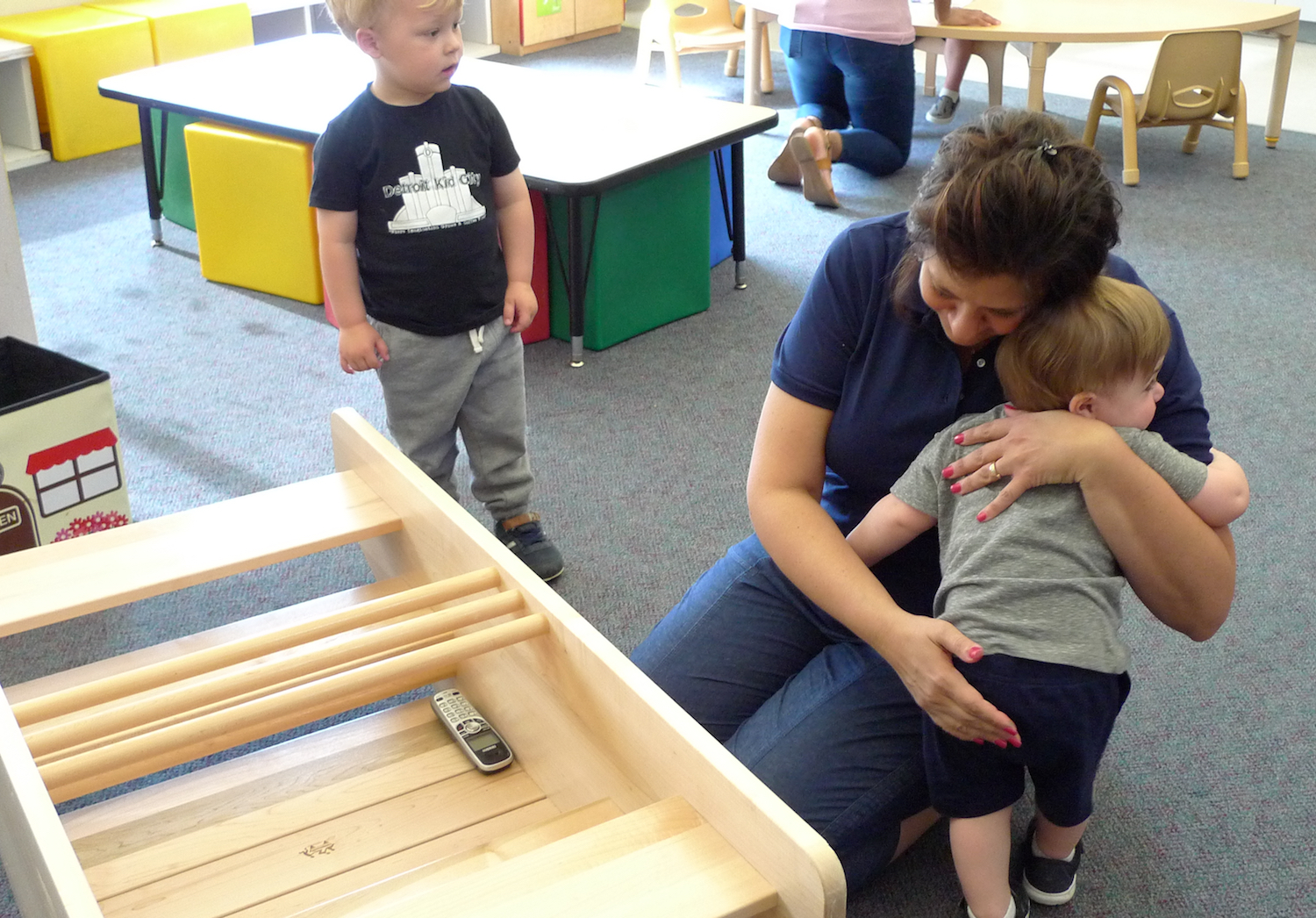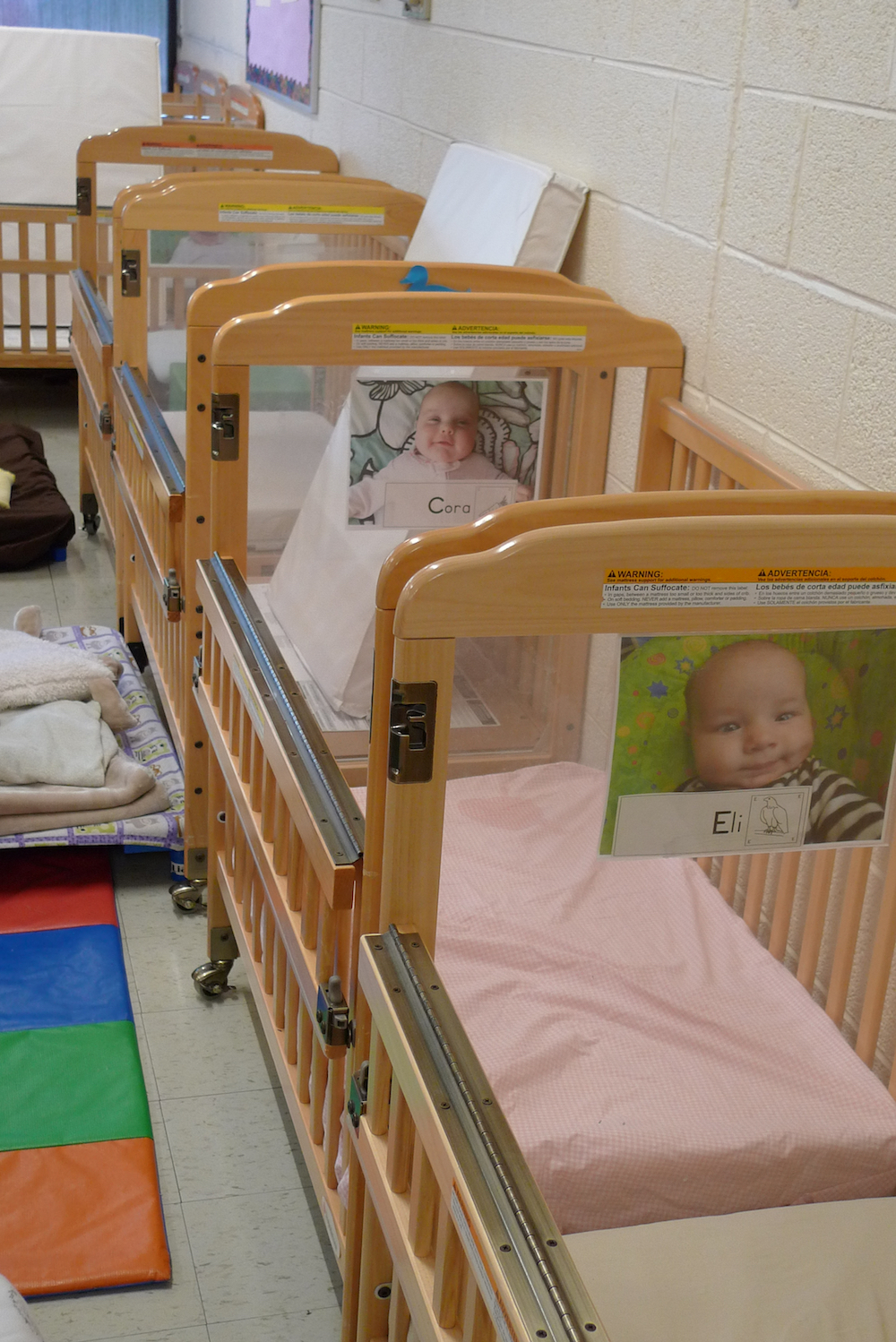Michigan’s low investment in child care costs state and poor children alike

It’s mid-morning at Berkley Building Blocks, just north of Detroit, a good time for children of all ages, but especially the little ones in this public school district’s day-care program. Carrying a four-star rating (out of a possible five) it is where about 330 children, from early infancy through preschool, spend all or part of their days, with more on a waiting list.
An impromptu jam session has broken out among a trio of children in the room for 3-year-olds. A girl plays a toy piano with the enthusiasm of a pint-size Jerry Lee Lewis while a boy drums to his own rhythm. The room is big enough that this concert doesn’t disrupt the room, or even attract much attention; similar self-directed play is happening all over.
The children are fortunate to have such a rich environment, which costs about $800 a month. But for the state’s poorest families, facilities like this one are often out of reach.
That’s because Michigan provides day-care centers like Berkley Building Blocks among the lowest reimbursement rates in the nation ($3.25 an hour for 3-year-olds), and only for the poorest low-income families. Of hundreds of children at the Berkley center, just nine families receive the federally funded, state-distributed subsidy for child care (the families have to make up the cost difference).
At a time when Michigan is looking to move more low- and moderate-income people into the workforce, while closing the achievement gap for their children, Michigan’s low investment in child-care can be a daunting obstacle for struggling families.
“You have to be really poor to get in, and then we don’t pay much to people who care for these kids,” said Bob Schneider, director of state affairs for the Citizens Research Council of Michigan, a nonpartisan public policy research group.
Moving from welfare to work
The federal program that subsidizes child care for low-income workers in Michigan was shaped during the welfare-reform era of the mid-1990s, when policymakers from the Clinton administration on down were looking for ways to push more people who relied on public assistance into the job market.
The thinking was, if policymakers were going to encourage welfare recipients to enter the workforce, some provision had to be made for the children they’d be leaving at home. And so what became an evolving program of block grants made to individual states began to take hold, with most of the money coming from the federal government and most of its administration and distribution left to the discretion of individual states.
But advocates for greater state investment say that the amount of government reimbursement -- which tops out at $4.75 an hour in Michigan for infant care -- amounts to what a parent would pay to the cheapest babysitter on the block. This at a time when research is revealing the enormous brain development that happens in children between birth and age 3, and its implications for later learning.
“There wasn’t a lot of heavy-duty research about 0-3” year-old children in the 1990s, said Susan Broman, who directs the Michigan Office of Great Start, part of the Department of Education, which oversees Michigan’s publicly funded child care and preschool programs. “So we start with that history of paying close to babysitting wages.”
Quality child care for the youngest of children generally costs around $10,000 a year, Broman noted, which amounts to roughly 40 percent of the gross wages for a worker who qualifies for Michigan’s Child Development and Care program, or CDC, making it unaffordable to many such families.
Michigan’s program ranks near the bottom nationally in helping low-income families afford quality childcare. The state has among the lowest income caps on families that are eligible, and offers among the lowest reimbursement to providers for care. What’s more, thousands of children whose families are eligible for care have left the program in the last decade, and no one can say where they are, or whether they’re being cared for.
The Citizens Research Council, along with Lansing-based Public Sector Consultants, produced a 2014 report on state policy options to improve the outlook for our youngest, poorest children. Of the child-care program, it recommended more investment by the state, among other changes.
But little has changed.
The income limit for eligibility stood for years at 121 percent of the federal poverty level, which amounts to about $24,394 for a family of three in 2016. The cap was recently raised to 125 percent, still one of the lowest levels in the country.
By way of comparison, as of 2011, California admitted families making up to 228 percent of the federal poverty threshold. North Carolina stood at 231 percent, which opens the program to families of three earning up to roughly $46,000, nearly twice the income cap placed on Michigan families.
Child-care advocates are calling for more expansion, with a major report due out later this summer, prepared by PSC for the state’s Office of Great Start.
But there appears to be little enthusiasm in Lansing for expanding eligibility among the legislators with sway over the program’s budget.
With the announcement in May that the state was taking in less tax revenue than previously projected, the subcommittee that oversees the child care program is thinking more frugally these days, approving only the minor expansion from 121 percent of federal poverty to 125 percent.
Phil Potvin, R-Cadillac, chairman of the Appropriations Subcommittee on the Department of Education, said the state deserved credit for funding a state expansion of preschool for 4-year-olds in the previous two years. But doing something similar for even younger low-income children will have to wait for bluer skies and fatter tax collections. And raising the eligibility threshold to 125 percent, he added, is progress.
“We’re improving it,” Potvin said. “It’s to the best of our ability at this particular moment. And it’s better than it was. We did something. We didn’t just sit there.”
An economic issue
Helen Blank sounds, at this moment, like a scolding governess who wants the misbehaving child in her charge to know how very, very disappointed she is.
“Oh, (Michigan) is rotten to the core,” she says from her office at the National Women’s Law Center in Washington D.C., where she is director of childcare and early learning. “It makes me weep. One of the saddest stories I know.”
The nonprofit center, which advocates for policies that promote greater opportunity for women and their families, tracks subsidized child care closely, seeing it as a key issue for working parents.
It isn’t just a nice-to-have benefit for the poor, Blank said, but a must-have benefit if low-income parents are to be able to fill new jobs being created in today’s economy, which especially in Michigan are disproportionately low-wage, with non-traditional, often erratic hours.
“Look at the needs of these moms,” said Blank. “I’m glad Michigan has a new investment in pre-K (for four-year-olds). That was good, but don’t exempt child care.”
(In 2013, the state expanded Great Start Readiness Program by $65 million a year, which allowed up to 30,000 lower-income 4-year-olds to attend quality preschool free of charge. Bridge reporting helped make the case for expanding the program to policymakers and the public.)
Blank said 22 percent of mothers of children under 3 in Michigan work in low-wage jobs and would generally qualify for child-care subsidies nationwide. Federal rules establish a broad framework for the program, but gives states considerable latitude in shaping it to their own states – and benefits vary widely.
“You have to understand what the value of this issue is to families and our economy,” Blank said. “(High-quality child care) helps children get a strong start to help them succeed, and it helps mothers work.”
Licensed care, or friends and family?
The federal Family and Medical Leave Act guarantees parents 12 weeks off from work, but that time is unpaid. Many have to put their children in the care of others at the earliest age a sitter or care center will accept them – usually six weeks. Consider the human infant at that stage, still very much a newborn – probably not yet smiling, perhaps still a little colicky, as helpless as when he or she left the womb.
“If you talk to parents, they will tell you that one of their most important values is that their child is with someone they trust,” Broman, of the state Great Start program, told Bridge.
That frequently means someone they know, which leads many to leave their children with friends, family or neighbors, who may or may not be licensed. Unlicensed providers can receive reimbursement in the state program. But they must complete a safety training course covering infant CPR, safe sleep, nutrition and related topics, at a one-time cost of $10 to the provider.
Licensed providers receive a higher reimbursement. The state also ranks them by quality, with the highest-quality centers receiving the highest subsidies.
See how licensed child-care centers near you are ranked.
How many Michigan children are cared for by unlicensed, unsubsidized providers is unknown. But Pat Sorenson, who analyzes the issue for the Michigan League for Public Policy, which advocates for lower-income Michiganders, points to some disquieting numbers.
Since 2005, “the number of low‐income Michigan parents receiving publicly subsidized care has dropped by two‐thirds, from nearly 65,000 to only 22,000,” Sorenson wrote in a 2014 policy memo. “Total child care spending (in the subsidy program) fell from $479 million in 2005 to just $136 million in 2014 – a reduction of over 70 percent.”
In other words, tens of thousands of Michigan children disappeared from the program. Where did they go?
Some left the state with their parents, in search of greener economic pastures, maybe. Others may stay home with their unemployed parents. But most are probably still in someone’s care, somewhere, Sorenson said, slipping into the sort of scrambling, catch-as-catch-can arrangements low-income workers often have to make, shifting children among friends, relatives and neighbors.
“It’s not stable,” Sorenson said. “What is the state of (this unlicensed) care? We know very little about it. It’s an underground market in a sense. Little is known about its quality, consistency, safety, etc.”
Who’s watching the baby?
Young children have been cared for by relatives or other adults throughout human history and have turned out fine, of course. But instability can leave children without the sort of consistent relationships and environments they need to thrive later in life, experts say.
“It’s really hard to say that one type of care is necessarily better than another,” said Patricia Cole, director of government relations for Zero to Three, a Washington D.C.-based nonprofit dedicated to translating what we know about early childhood research into policy and resources.
“Children need a nurturing relationship with an adult, and the adult needs to know how to support that development. It’s not that one type is better, but parents need options, and when you take away resources, they lack options.”
If the only available option is a home-based, friends-and-family arrangement, the best strategy is to make it as excellent as possible, said Jeff Guilfoyle, formerly with the Citizens Research Council and now with Public Sector Consultants. (Disclosure: The Center for Michigan, which publishes Bridge, is a client of PSC.)
“I have come full circle on this issue,” Guilfoyle said. “When I first started looking at it, I thought if we’re going to use public dollars for child care, we should only support the highest-ranking centers. But having worked on this, I’ve completely changed my opinion. The reality on the ground is, these kids are not in (child-care) centers, they’re not going to be in centers any time soon, and if you want to do well by these kids, we need to invest in improving (friends/family/neighbor) care.”
Guilfoyle said even if the state raises reimbursement to caregivers, Michigan lacks the capacity – i.e., the classroom space – to put all eligible children in high-quality child-care centers. But improving existing arrangements can be a delicate issue, for many reasons, starting with cost but also requiring providers – some of whom may be grandparents of the children in their care – to acknowledge they may yet have something to learn about caring for children.
The money paid through the program is not only for reimbursement, but training. The idea is similar, Guilfoyle said, to visiting-nurse programs that train new parents how best to care for and interact with growing infants in ways that benefit both. A 2015 Bridge series showed that such programs, while costly, pay for themselves because they lead to mothers to spend less time on government assistance while also producing better academic and social outcomes for their children.
“Dozens of studies have been done with random selection, that follow these kids for decades, and can see results into adulthood,” said Guilfoyle. “It makes a big difference early on.”
Inside a care center
So what does quality child care look like?
At Berkley Building Blocks, babies can go into care at six weeks. In the infant room, teacher Heather Blauer was holding an eight-month-old on her lap one day, while another child practiced crawling on a mat at her feet. Cribs lined a wall, each decorated with a color photo of its current claimant. A chart on the wall behind her told the age of each baby.
Blauer stroked the downy hair of the baby with as much tenderness as a mother. Infant care at this stage is about “just being available,” as well as engaging in the “give and take of conversation” with children starting to babble, Blauer said.
Down the hall, young toddlers are in a room of their own, all under 2, playing ring around the rosie. Older children a few doors away are in seats at a half-circle table, conducting an experiment of sorts – they’re speculating on which of their candy bars will float or sink, then testing their theories. More are outside playing on a water table with Miss Raana, a treat on a warm day after a chilly spring. Next to this space are two gardens, one planted with vegetables the students will tend and, with luck, sample later in the season.
On cold or rainy days, children can play in an open indoor space, with a climbing apparatus, push toys and other diversions. In nearly every corner, there’s a place for curious, growing, energetic children to find some activity that will engage or energize their growing minds.
The staff ratio for infants is 1:4, sometimes 1:3; for older children, 1:8; and for preschoolers, 1:12. For nine-hour days, five days a week, year-round, parents will pay anywhere from $711 (for preschoolers) to $968 (for infants).
Berkley has a Head Start and Great Start preschool program, which accepts low- to moderate-income children, but those nine families using state vouchers for the child-care program are expected to make up the difference between what the state provides and the full tuition cost, said district spokeswoman Jessica Stilger. (The center is currently going for a five-star rating, but said that during the course of its reassessment period is automatically listed on state databases as having three stars.)
A critical budget shortfall
Kristy Pagan, D-Canton, ranking Democrat on the House subcommittee on education appropriations, said more investment in child care “will help lift families out of poverty, and give our youngest children a chance to have a running start.”
She offered an amendment to increase the eligibility threshold to 150 percent of the poverty line (around $30,000 for a family of three), which failed along party lines, she said. In addition to raising the cap to 125 percent instead, the legislation gave the children of Flint a special carve-out as part of their focused recovery from the lead water crisis; parents in Flint can make up to 300 percent of federal poverty and qualify for state-supported child care.
Pagan points out that Michigan could receive another $20 million in federal money for this program, if the legislature was willing to put up $7 million in general fund dollars as the state’s match.
But that’s money the state can ill afford, Potvin, the Republican subcommittee chairman said.
“The true wakeup call came with revenue estimating,” he said, referring to the shortfall in state income revealed this spring. “It forced us to not be as generous as we had hoped to be.”
See what new members are saying about why they donated to Bridge Michigan:
- “In order for this information to be accurate and unbiased it must be underwritten by its readers, not by special interests.” - Larry S.
- “Not many other media sources report on the topics Bridge does.” - Susan B.
- “Your journalism is outstanding and rare these days.” - Mark S.
If you want to ensure the future of nonpartisan, nonprofit Michigan journalism, please become a member today. You, too, will be asked why you donated and maybe we'll feature your quote next time!


 A jam session at the
A jam session at the  A boy runs in for a quick hug from his teacher before heading out for more play.
A boy runs in for a quick hug from his teacher before heading out for more play. Cribs at Berkley Building Blocks are assigned to specific children, ID’d by photos.
Cribs at Berkley Building Blocks are assigned to specific children, ID’d by photos.